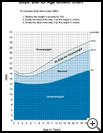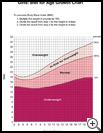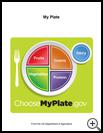
Healthy Meal Planning for Children
How can I get my children to eat healthy foods?
Many parents are realizing that rushed schedules and too many dinners from fast food restaurants are affecting the way their children eat and see foods. The best way to get your kids to eat well is to be a role model and to get them involved in meal planning. Eating healthy is always a family affair. Whether your children are very young and you are looking to start them out "right" or they are already in the habit of eating too many high fat, high sugar foods, you can use these tips to help your family eat healthy meals.
Where do I start?
Children should be offered a variety of foods from all food groups including whole grains, fresh fruits and vegetables, low-fat or skim dairy products, lean meats, fish, poultry, and beans. A good rule of thumb in choosing the healthiest versions of these foods is "the less processed, the better." Processed foods are usually prepackaged foods like crackers, cookies, instant noodle and rice mixes, sugary cereals, and breads made with white flour.
- Use the ChooseMyPlate method to teach your kids how to eat a balance of healthy foods in the right amounts.
The ChooseMyPlate method divides the plate into 4 food groups: fruit, vegetable, grains, and protein. You can use this plate to choose foods for breakfast, lunch, and dinner. Simply fill half of a 9-inch plate with fruits and vegetables. The other half of the plate should be split between starches (such as whole grains and starchy vegetables like potatoes) and lean proteins, like lean meat, beans, and peas. A cup of low-fat or skim milk or yogurt on the side is ok.
- Go shopping. See what's in your cupboards. If you usually buy high-fat, high-sugar snacks, sodas, sugary fruit drinks, and baked goods, you'll need to change your shopping habits. Children get used to having these foods available and will choose them over fresh fruits, yogurt, or other healthy snacks. Writing out a shopping list really helps. Let your kids help write the "new" list.
- Change cereals. Switch from high-sugar cereals to those that are only lightly sweetened and are high in fiber. If your children really complain, dress them up with fresh fruit or allowing a "mix." A mix is a healthy cereal with a small handful of sweet cereal on top.
- Serve more whole grain products. At least half of the grain products your children eat should come from whole grains. Whole grains include whole wheat, whole oats, whole-grain corn, brown rice, and whole grain barley.
- Serve low-fat milk. If your children are over 2 years of age, switch to low-fat or skim dairy products. Children should get used to lean milk products early. Encourage 2 to 3 servings a day. Offering cold cereal or making oatmeal with milk can add an additional serving of milk for those children that don't care for drinking milk. Water and low-fat milk should be offered more frequently than juice. While 100% juice is nutritious, it is also very high in calories and can become a problem for children at risk for being overweight. It is best to limit juice to 8 ounces (1 cup) per day.
- Serve less meat and make it lean. Prepare only the leanest cuts of meats, pork, and poultry without skin. Fish is also a great choice. Try having a meatless lunch or dinner a few times a week, using beans or soy products.
- Serve more fruits and vegetables. Most children don't eat enough fruits and vegetables. Take every opportunity to serve them. Breakfast and snack times are perfect for fruit. All lunch and dinner meals should be served with vegetables. Always have a full fresh fruit bowl on the counter and baby carrots in the refrigerator for snacking. Offer vegetables to dip in low-fat dressing. Vegetable soups and colorful salads are good appetizers. Try making a salad with baby spinach, mandarin oranges, crushed nuts and fruit-based dressing. Include the kids in making up new salad combinations.
- Vary the vegetables. Try to select from all 5 vegetable "subgroups" (dark green, orange, legumes, starchy vegetables, and others) several times a week.
- Don't eat out as much. Try to eat at fast food restaurants less often. If you are just picking up food to take home, try ordering the entrée only. Skip the fries, high- fat side dishes, and soda. Serve burgers with fresh fruit, leftover corn on the cob, and milk or juice. Be creative.
- Limit fats. Avoid offering too much saturated fat such as butter, sour cream, and cream cheese. Cook with canola or olive oils and use only very soft or tub margarines (look for those without trans-fats). Choose low-fat dressings and light mayonnaise.
- Give kids a chance to get used to new foods. When trying new foods, realize that children are not small adults. They react to textures and flavors differently, and some foods, like certain strong smelling vegetables and rough grains will not be something they like until they are older. Many kids won't try a new food until it is offered many times. Continue to offer a variety of food but try not to become frustrated or force them to eat new foods.
- Help your kids control the amount they eat. Even if you spend a lot of time making a dish, don't make your children clean their plate when they tell you they're full. Serve small portions. If your child is still hungry, he or she will ask for more. Some children want very large portions and eat past the point of being full. This puts them at risk for being overweight. The key to encouraging good eating habits is for you to offer healthy foods and allow seconds of fruit, vegetables and salad, while limiting other foods to 1 portion.
- Have scheduled meals and snack times. Children, especially younger ones, like to know what to expect. Family dinners are very important and are often the only time when the whole family is together.
How do I fit a healthy diet into our busy schedule?
If you have a busy schedule, go shopping and stock your cupboards with quick, healthy choices for the week. Always have basic foods available to prepare fast, simple and nutritious meals.
Basics for your shopping list:
- low-sugar, high-fiber cereals
- whole wheat bread, rice (brown is best), pasta, corn tortillas, other whole grains
- fresh, frozen, dried, or canned fruit (in own juice or light syrup)
- fresh, frozen, or low salt canned vegetables
- leafy vegetables for salads
- fresh or frozen lean meats like skinless chicken or turkey breasts, pork tenderloin, sirloin or round steak, and fish (water packed tuna is convenient)
- eggs or egg substitute
- low-fat or skim milk, nonfat yogurt, lean cheese (such as cottage cheese or string cheese)
- tofu or soy milk
- nuts and seeds (for kids over 5 years)
- olive and canola oil
- graham crackers
- healthy snacks that your family has agreed upon.
Families are usually busy in the morning when everyone is getting ready for school and work. Finding time to make dinner and eat together is often difficult as well. If you plan ahead, you can have the right ingredients to make quick and healthy meals.
Breakfast ideas:
- cold cereal topped with fruit, toast with light margarine or jelly, glass of milk
- waffles with light syrup, fresh fruit, milk
- oatmeal and raisins made with milk
- toast with peanut butter, fruit and milk
- yogurt with low-fat granola
- instant breakfast drink
- low-fat breakfast bar.
- scrambled eggs with waffles, toast, or rolled in a tortilla
- bran muffin with fruit and yogurt
Dinner ideas:
- Prepare what you can the night before (such as marinating or thawing out meat).
- Keep meals simple such as: vegetable soup, baked pork tenderloin, rice, broccoli, and a glass of milk.
- Try to make enough meat, rice, or pasta so there will be enough left over to use to make a quick meal the next night.
- Use a Crock Pot to put together a soup or bean dish in the morning so dinner is already prepared in the evening.
What should I do if my child is overweight?
If you are concerned that your child is overweight, talk to your child's healthcare provider. Children are rarely put on calorie-restricted diets because it can affect normal growth. Kids often gain too much weight from overeating high-calorie snacks and fast foods, drinking too much soda and juice, and lack of exercise. The healthy meal planning tips given here are appropriate for both normal weight and overweight children.
You can get more information about healthy eating from the ChooseMyPlate Web site at http://www.choosemyplate.gov/
Last modified: 2011-07-06
Last reviewed: 2011-07-05



